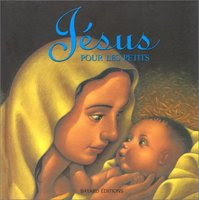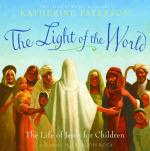This book started when I stopped by my friend Rachel Griffiths's desk, something I do at least once a day. Rachel had just met with the agent Kendra Marcus, who represents a number of foreign publishers in their U.S. business dealings, and a few books were stacked on the edge of her desk. Since Rachel was finishing an e-mail, I picked one up -- Jesus pour les petits -- and started to leaf through it while I waited.
"This is really beautiful," I said, turning the pages. "Oh, wow, really beautiful -- look at this." The illustrations were by Francois Roca, a French artist Arthur had loved for years and who I'd come to love as well, and like all his work, the gorgeous paintings in this book had Hopperesque lighting and composition and yet Renaissance texture and warmth -- a perfect combination of old techniques and new aesthetics. "Do you want this?" I asked Rachel. "Could I take it and look at it a bit more?"
"Sure," she agreed, and I went back to my desk to study the book further. It was 96 pages, with each page of simple text on the left facing a beautiful, iconic image from Jesus's birth, life and teachings, or death and resurrection on the right. I can't read French, but I fell in love with the images: a radiant Mary, the boy Jesus running past a house in Nazareth, the preacher Jesus sitting beneath a tree with his disciples, three crosses against a stormy sky. Jesus was never seen full face, and was consistently viewed from some distance away, so he remained always a figure of mystery; but the softness of the edges and the warmth of the colors around him made him approachable and human. This was the Jesus I had grown up with, as far away as God and yet right there to listen, and by the time I closed the book again, I knew I wanted to publish it.
I also knew it would be a lot of work, as the economics of the American publishing market were (and are) not instantly supportive of a 96-page French picture book with only its subject and beauty as selling points. The length would mean a high unit cost; the Frenchness would require a translation; the subject had been covered before (to say the least), so there was competition; and it can be difficult to get people to stop and appreciate beauty -- even beauty as obvious (to me, anyway) as the paintings in this book. The book would need something more to be published here, a prominent author or distinctive voice, someone like --
"Katherine Paterson," I said. I was sitting in Arthur's office now for my weekly meeting with him, and we were talking about how we could make these paintings work as a U.S. picture book. There was imprint precedent for pairing illustrations from a foreign picture book with text by another author: Three years before, Arthur had published a text for
Confucius: The Golden Rule by Russell Freedman alongside previously published illustrations by Frederic Clement. [I should also note that I had checked again with Rachel to be sure she didn't mind letting the book go, and because she didn't share my background with or interest in the subject matter, she kindly passed it on.] Mrs. Paterson's name just popped into my head as I was speaking -- hadn't I read that she was a minister's wife? But surely she had done a book like this before . . . ? And would she want to write text for pre-existing illustrations? Would it be too presumptuous to ask?
In any case, Arthur agreed that Katherine Paterson would be great for this, so I went back to my desk and did a little research at
http://www.katherinepaterson.com/. She was indeed the wife of a minister and the daughter of missionaries -- she had even done mission work herself. There was no other Jesus biography listed among her publications. And then I came across this lovely statement on her
FAQ: "The challenge for those of us who care about our faith and about a hurting world is to tell stories which will carry the words of grace and hope in their bones and sinews and not wear them like fancy dress. "
That spoke incredibly deeply to me. For while my own faith may be defined some days as a struggle to have it at all, I do try to hold to the vision Jesus preached for all people: to love one another, and be kind and just to one another, and believe always in the possibility of both small and radical change for good -- and to attempt to live those beliefs much more than talk about them. And here Mrs. Paterson was applying that philosophy to stories, my other religion, and with such humility and grace herself. . . . I wrote to her in great fear and trembling, explaining my long admiration for her books and hopes for the project, and telling myself I had nothing to lose.
It was one of the best days in my publishing life when I heard she was interested. Many letters then passed back and forth, between me and Mrs. Paterson, me and her agent, me and Bayard Presse (the French publisher), me and Kendra Marcus -- and probably Mrs. Paterson and her agent, Bayard and Kendra, Bayard and Francois as well. The French author, Marie-Helene Delval, graciously agreed to let Mrs. Paterson's text replace her own. We tightened the narrative from 96 leisurely pages to 48 more focused ones. I flipped through various Bible translations to check quotations and parables, and, in the course of our correspondence, slowly dared to think of two-time-Newbery-Medalist, National-Book-Award-honoree, Astrid-Lindgren-Prizewinner Mrs. Paterson as "Katherine." (It helped that she is, I swear, the nicest and most humble woman on the planet -- who would probably bristle at that description because she is the nicest and most humble woman on the planet, but so it goes.)
I also came to appreciate her deceptively simple text for the book -- because how do you explain a story as complicated as Jesus's to a four-year-old? Even if you don't believe in his divinity, the mythology surrounding him encompasses sex, politics, history, religion, extreme violence, miracles, the very mystery of life and death. Katherine puts it all in terms a child could understand -- a phrase that is usually an insult, but here demonstrates her great understanding of and sympathy for children: For example, she identifies Jesus's disciples as his friends, and says that when they left him, he felt very alone. A four-year-old could know and appreciate that feeling of loneliness and abandonment. She frames the story, as the French book did, with images of light -- first the light prophesied by Isaiah, then at the crucifixion, "The light of the world had gone out." Again, any four-year-old alone in the dark would comprehend how this feels. And finally, my favorite line: "The light still shines through everyone who, like Jesus, lives the good news of God's loving kingdom." The book doesn't just tell children about Jesus's words of grace and hope, it teaches them that they (and we) can make a difference in a hurting world.
Francois's art takes this same relateable approach in making the story comprehensible to children: One illustration shows many followers of Jesus smiling; the next spread has the same layout, but different individuals, all of whom are frowning -- visually creating the transition in public opinion leading toward the crucifixion. (The book does not assign responsibility for the crucifixion to any particular group -- beyond any controversies, again, that's not something a four-year-old would be interested in or need to know.) The result is, I think, as beautiful and child-friendly as any picture book about Jesus out there, and one I never looked at without feeling incredibly privileged to be working with two such amazing artists.
After the content of the layouts was finalized, our designer Leyah Jensen created a big, spacious design, putting the 8" x 8" art -- which had originally been full bleed -- into a one-inch frame for a 10" x 10" trim size. The result feels lovely and gifty, a book you could give children for baptisms and first communions as well as Christmas or Easter. Along similar year-round lines, the gorgeous French cover art had featured a scene from the nativity--

-- but we wanted to emphasize Christ's whole life over merely his birth, so we commissioned new jacket art from Francois, who delivered the piece you see at the top. (This nativity piece is now on the back cover.) I'm fascinated by the new jacket because every time I look at it, I find my eyes focusing not on Jesus, but the common people around him -- their expressions of love, trust, wonder, and joy -- which fits perfectly with Katherine's text about where light continues to shine: in us, if we choose to live it, every day.
The Light of the World: The Life of Jesus for Children came out this month, and as I noted earlier, has already received two starred reviews, from Kirkus and Booklist. It is perhaps my mother's favorite book I've ever edited -- which means quite a lot to me, that I helped make something that means so much to her. Altogether, I love this book dearly, and if you have the chance to see it, I hope you love it too.







 Mary Peterson
Mary Peterson